organic trace elements on a hyper-prolific sow herd
The effect of the addition of organic trace elements on the performance of a hyper-prolific sow herd
Published: December 18, 2006
By: ROBERT FEHSE and WILLIAM H. CLOSE - Fehse Consultancy/Close Consultancy (Courtesy of Alltech Inc.)
For sows to remain hyper-prolific throughout their lives and to maintain a high level of production it is important that their nutritional and metabolic needs are met at all stages of reproduction. It is known that nutrition, by influencing the endocrine and physiological status of the sow, affects both short- and long-term reproductive capacity.
In terms of nutrition, major emphasis has been directed towards meeting energy, protein and amino acid requirements. Macrominerals, such as calcium and phosphorus and some vitamins are also taken into account. A very important source of nutrients, the trace minerals, are often neglected and their role in reproduction is often underestimated. A deficiency of these trace elements can cause a considerable reduction in performance. The potential role of some trace minerals in influencing sow productivity is suggested in Figure 1.
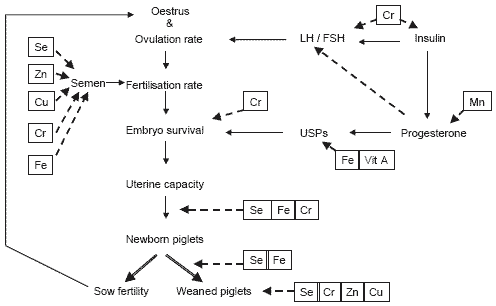
Figure 1.The role of trace elements in sow reproduction (Close, 1999).
Mineral requirements are dependent upon the level of production and in the modern animal with its high level of performance, it may well be that the requirements are higher than current recommendations, including ARC (1981) and NRC (1998). For example, Mahan and Newton (1995) have shown that the body mineral content of sows at the end of their third lactation was considerably lower when the mean litter weight at 21 days was above 60 kg than below 55 kg and well below that of non-breeding animals of similar age (Table 1). This suggests that significant de-mineralisation of the sow skeletal structure occurred to meet the needs of the higher performing animals. Although the animals were fed to normal recommendations, the losses from all body tissues were substantial when compared with nonbreeding sows of similar age. This raises questions about the mineral requirements of the modern hyper-prolific sows, the actual forms and amounts needed in the feed, and availability of these mineral sources to the animal. This has prompted interest in the use of organic minerals, which are more bioavailable and bioactive within the animal than the corresponding inorganic sources normally provided.
Table 1.Mineral content in the body of the sow.
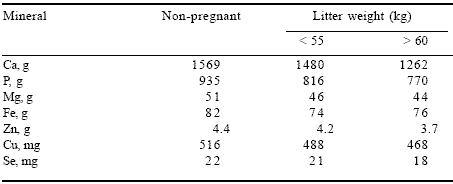
Mahan and Newton, 1995.
Indeed, several recent commercial trials have shown that inclusion of organic minerals in sow diets has improved overall sow and piglet performance in terms of litter size, with less piglet mortality pre-weaning, higher sow feed intake and higher piglet weaning weights.
The objective of the present trial was therefore to establish whether a special supplement of organic minerals provided in addition to the normal inorganic sources of minerals in the diet of the gestating and lactating sow influenced sow and piglet performance. This special supplement contained several organic (Bioplex) minerals manufactured by Alltech Inc., (Nicholasville, Kentucky, USA) and was called 'Sow Pak'.
The trial was carried out on a research farm in Switzerland and therefore some information on pig production in Switzerland is provided.
Pig production in Switzerland
Pig production in Switzerland is very intensive and sophisticated. Feed costs are high; and as a consequence the use of by-products, in combination with computerised wet-feeding, is widespread. There are strict regulations on pollution control and animal welfare, which increase production costs. Dietary antibiotic growth promoters have been prohibited since July 1999. The main swine diseases are enzootic pneumonia, APP, rhinitis etc.; and these should be eradicated with the help of a national health care programme (SPF system) within the coming years. Currently about 50% of all piglets are produced in this high health system.
Economically, pig production contributes 14% to the Swiss agricultural output. The national herd has been decreasing since 1980 and the same trends can be observed in the consumption of pig meat, although there was a slight improvement in 1998 (Table 2).
Table 2.Swiss pig production: some key figures.

The live weight at slaughter is between 100 and 105 kg. There are premiums and deductions for weight range, lean percentage, pH and fat quality (free fatty acids).
Prices and costs are roughly double those in the rest of Europe; and for a long time the market had been protected. However, because of WTO regulations, imports must now be accepted and these are increasing each year (Table 2). This means that Switzerland must adopt European prices within the next 5 to 10 years and it is therefore imperative to reduce production costs and to increase productivity, especially in piglet production, if the Swiss pig industry is to remain competitive.
Response to Sow Pak in a hyper-prolific herd
COMPOSITION AND ANALYSIS OF MINERALS IN THE FEEDS
It is normal practice to add a mineral supplement to the diet of the breeding sow. However, as indicated in Figure 1 and Table 3, specific elements play significant roles in reproduction, such as chromium, selenium, iron, zinc, manganese and copper. A special supplement of these minerals in organic form was therefore prepared and added to the regular inorganic mineral supplement. The composition of the regular inorganic supplement and the proposed added levels of the organic elements are shown in Table 4.
Table 3. The role of specific trace elements in sow reproduction.
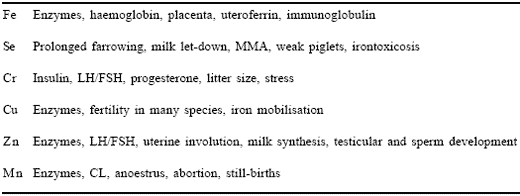
Table 4.The contribution of the regular inorganic and proposed Bioplex mineral supplements (Sow Pak) to total diet mineral content.

De-Odorase was added as there was evidence to suggest that the action of the Yucca plant extract in improving air quality also enhances oxygen-carrying capacity and therefore reduces the number of stillborn piglets.
Samples of both the gestation and lactation feed, with and without the Sow Pak, were taken regularly throughout the study and analysed for mineral content. Since the Sow Pak was added to both the gestation and lactation feed, the values have been combined to show the actual quantities provided in the diets (Table 5) together with the actual and intended inclusion levels of the Sow Pak supplement.
Table 5.The mineral content (mg/kg) of the diets (Mean ±SD).

The increase in the zinc and copper level was exactly as intended, but that for iron was higher and that for manganese lower. However, iron is likely to be a more limiting element in terms of reproduction and normally provokes a more positive and greater response than manganese. Indeed, the actual analysed level of iron in the diet was much higher than intended and the reasons for this are unknown. Nevertheless, the mineral content in all diets adequately covered the accepted recommended requirements.
Analysis of the Sow Pak showed that it also contained 0.151 ppm Se and 220 ppb Cr and when added to the diets these levels were close to the levels intended of 0.175 ppm Se from Sel-Plex and 200 ppb Cr from Bio- Chrome.
These data show that the difference in the mineral composition between the control diet and that supplemented with Sow Pak was as intended and any changes in the performance of the sows can be attributed to the higher levels of organic minerals in the diets augmented with Sow Pak.
MATERIALS, METHODS AND ROUTINE MANAGEMENT ON FARM
The trial started in March 1997 and ended in March 1999. Beginning at lactation, the sows were allocated to the two treatments (control and Sow Pak), farrowing room by farrowing room, until half of the herd was on the Sow Pak diet and half on the control diet. These were then fed until the end of the experiment. The trial therefore spanned a range of sow parities from parity 2 to parity 12.
The trial was carried out on the experimental farm of Rüti AG, a subsidiary of the feed company Haefliger AG, one of the most important in Switzerland. It is a commercial farm with 150 sows (the legal maximum), which are housed in groups during pregnancy and confined in individual pens during farrowing and lactation. Weaning is carried out at four weeks of age. The Large White herd has been selected for the past 20 years as a female line with maximum priority on prolificacy. A sophisticated vaccination programme, professional management and the use of medicated feed for a two week period after weaning guarantee maximum health status.
The feeding strategy of the sows is based on a two phase feeding regime with a higher fibre diet in gestation and a more nutrient-dense diet in lactation. The chemical composition of the diets used in the trial is presented in Table 6.
Table 6.Chemical analysis of the diets.

VES = Swiss energy system for swine (Verdauliche Energie, Schwein)
A basic feeding regime of 1% of body weight per day is provided during pregnancy. This ration is fine-tuned at weaning when body condition score is taken into account. The gestation diet has a high fibre content, which allows higher feed levels so that the sows feel more satiated and content, resulting in better welfare.
During lactation, a semi-ad libitum feeding regime is used. At farrowing, the lactation diet is provided initially at about 2 kg/day and this is gradually increased until a defined quantity is reached and thereafter it is kept constant to the end of lactation. The quantity provided depends on the condition of the sow and the number of suckling piglets, as indicated in Table 7.
These dietary guidelines are modified depending on body condition. The ration is weighed daily into a special ad libitum feeder. The sow is then able to eat as often as she likes and to consume the feed in small portions with minimal wastage.
Table 7. Daily feeding regime in lactation from week 2 of lactation to weaning.

*depending on the litter performance.
The following data were routinely recorded during the trial:
In terms of nutrition, major emphasis has been directed towards meeting energy, protein and amino acid requirements. Macrominerals, such as calcium and phosphorus and some vitamins are also taken into account. A very important source of nutrients, the trace minerals, are often neglected and their role in reproduction is often underestimated. A deficiency of these trace elements can cause a considerable reduction in performance. The potential role of some trace minerals in influencing sow productivity is suggested in Figure 1.

Figure 1.The role of trace elements in sow reproduction (Close, 1999).
Mineral requirements are dependent upon the level of production and in the modern animal with its high level of performance, it may well be that the requirements are higher than current recommendations, including ARC (1981) and NRC (1998). For example, Mahan and Newton (1995) have shown that the body mineral content of sows at the end of their third lactation was considerably lower when the mean litter weight at 21 days was above 60 kg than below 55 kg and well below that of non-breeding animals of similar age (Table 1). This suggests that significant de-mineralisation of the sow skeletal structure occurred to meet the needs of the higher performing animals. Although the animals were fed to normal recommendations, the losses from all body tissues were substantial when compared with nonbreeding sows of similar age. This raises questions about the mineral requirements of the modern hyper-prolific sows, the actual forms and amounts needed in the feed, and availability of these mineral sources to the animal. This has prompted interest in the use of organic minerals, which are more bioavailable and bioactive within the animal than the corresponding inorganic sources normally provided.
Table 1.Mineral content in the body of the sow.

Mahan and Newton, 1995.
Indeed, several recent commercial trials have shown that inclusion of organic minerals in sow diets has improved overall sow and piglet performance in terms of litter size, with less piglet mortality pre-weaning, higher sow feed intake and higher piglet weaning weights.
The objective of the present trial was therefore to establish whether a special supplement of organic minerals provided in addition to the normal inorganic sources of minerals in the diet of the gestating and lactating sow influenced sow and piglet performance. This special supplement contained several organic (Bioplex) minerals manufactured by Alltech Inc., (Nicholasville, Kentucky, USA) and was called 'Sow Pak'.
The trial was carried out on a research farm in Switzerland and therefore some information on pig production in Switzerland is provided.
Pig production in Switzerland
Pig production in Switzerland is very intensive and sophisticated. Feed costs are high; and as a consequence the use of by-products, in combination with computerised wet-feeding, is widespread. There are strict regulations on pollution control and animal welfare, which increase production costs. Dietary antibiotic growth promoters have been prohibited since July 1999. The main swine diseases are enzootic pneumonia, APP, rhinitis etc.; and these should be eradicated with the help of a national health care programme (SPF system) within the coming years. Currently about 50% of all piglets are produced in this high health system.
Economically, pig production contributes 14% to the Swiss agricultural output. The national herd has been decreasing since 1980 and the same trends can be observed in the consumption of pig meat, although there was a slight improvement in 1998 (Table 2).
Table 2.Swiss pig production: some key figures.

The live weight at slaughter is between 100 and 105 kg. There are premiums and deductions for weight range, lean percentage, pH and fat quality (free fatty acids).
Prices and costs are roughly double those in the rest of Europe; and for a long time the market had been protected. However, because of WTO regulations, imports must now be accepted and these are increasing each year (Table 2). This means that Switzerland must adopt European prices within the next 5 to 10 years and it is therefore imperative to reduce production costs and to increase productivity, especially in piglet production, if the Swiss pig industry is to remain competitive.
Response to Sow Pak in a hyper-prolific herd
COMPOSITION AND ANALYSIS OF MINERALS IN THE FEEDS
It is normal practice to add a mineral supplement to the diet of the breeding sow. However, as indicated in Figure 1 and Table 3, specific elements play significant roles in reproduction, such as chromium, selenium, iron, zinc, manganese and copper. A special supplement of these minerals in organic form was therefore prepared and added to the regular inorganic mineral supplement. The composition of the regular inorganic supplement and the proposed added levels of the organic elements are shown in Table 4.
Table 3. The role of specific trace elements in sow reproduction.

Table 4.The contribution of the regular inorganic and proposed Bioplex mineral supplements (Sow Pak) to total diet mineral content.

De-Odorase was added as there was evidence to suggest that the action of the Yucca plant extract in improving air quality also enhances oxygen-carrying capacity and therefore reduces the number of stillborn piglets.
Samples of both the gestation and lactation feed, with and without the Sow Pak, were taken regularly throughout the study and analysed for mineral content. Since the Sow Pak was added to both the gestation and lactation feed, the values have been combined to show the actual quantities provided in the diets (Table 5) together with the actual and intended inclusion levels of the Sow Pak supplement.
Table 5.The mineral content (mg/kg) of the diets (Mean ±SD).

The increase in the zinc and copper level was exactly as intended, but that for iron was higher and that for manganese lower. However, iron is likely to be a more limiting element in terms of reproduction and normally provokes a more positive and greater response than manganese. Indeed, the actual analysed level of iron in the diet was much higher than intended and the reasons for this are unknown. Nevertheless, the mineral content in all diets adequately covered the accepted recommended requirements.
Analysis of the Sow Pak showed that it also contained 0.151 ppm Se and 220 ppb Cr and when added to the diets these levels were close to the levels intended of 0.175 ppm Se from Sel-Plex and 200 ppb Cr from Bio- Chrome.
These data show that the difference in the mineral composition between the control diet and that supplemented with Sow Pak was as intended and any changes in the performance of the sows can be attributed to the higher levels of organic minerals in the diets augmented with Sow Pak.
MATERIALS, METHODS AND ROUTINE MANAGEMENT ON FARM
The trial started in March 1997 and ended in March 1999. Beginning at lactation, the sows were allocated to the two treatments (control and Sow Pak), farrowing room by farrowing room, until half of the herd was on the Sow Pak diet and half on the control diet. These were then fed until the end of the experiment. The trial therefore spanned a range of sow parities from parity 2 to parity 12.
The trial was carried out on the experimental farm of Rüti AG, a subsidiary of the feed company Haefliger AG, one of the most important in Switzerland. It is a commercial farm with 150 sows (the legal maximum), which are housed in groups during pregnancy and confined in individual pens during farrowing and lactation. Weaning is carried out at four weeks of age. The Large White herd has been selected for the past 20 years as a female line with maximum priority on prolificacy. A sophisticated vaccination programme, professional management and the use of medicated feed for a two week period after weaning guarantee maximum health status.
The feeding strategy of the sows is based on a two phase feeding regime with a higher fibre diet in gestation and a more nutrient-dense diet in lactation. The chemical composition of the diets used in the trial is presented in Table 6.
Table 6.Chemical analysis of the diets.

VES = Swiss energy system for swine (Verdauliche Energie, Schwein)
A basic feeding regime of 1% of body weight per day is provided during pregnancy. This ration is fine-tuned at weaning when body condition score is taken into account. The gestation diet has a high fibre content, which allows higher feed levels so that the sows feel more satiated and content, resulting in better welfare.
During lactation, a semi-ad libitum feeding regime is used. At farrowing, the lactation diet is provided initially at about 2 kg/day and this is gradually increased until a defined quantity is reached and thereafter it is kept constant to the end of lactation. The quantity provided depends on the condition of the sow and the number of suckling piglets, as indicated in Table 7.
These dietary guidelines are modified depending on body condition. The ration is weighed daily into a special ad libitum feeder. The sow is then able to eat as often as she likes and to consume the feed in small portions with minimal wastage.
Table 7. Daily feeding regime in lactation from week 2 of lactation to weaning.

*depending on the litter performance.
The following data were routinely recorded during the trial:
- Condition of the sow throughout the cycle
- Weight, backfat thickness (P2) measurements, body score condition
-At mating -Before farrowing (on entering the farrowing room)
-At weaning (The weight of the sows after farrowing was calculated from the litter weight at birth.)
- Feed consumption
-In gestation: group, daily
-In lactation: individually, daily
- Performance of the sow
-Pedigree, birth date, on-farm testing
-Reproduction data, including total piglets born, born alive and weaned, piglet weight at birth and weaning and pre-weaning mortality
More details on management and husbandry on the farm are provided by Fehse (1999).
RESULTS
General comments In all, the trial involved 742 litters of piglets from sows ranging between parities 2 and 12; 386 on the control and 356 on the Sow Pak diets. However, despite this large data set, there was considerable variation in many of the parameters measured and although there were numerical differences between treatments, few of these were statistically different at P<0.05. This is not surprising, since it is well known that it takes very large sow and piglet numbers to establish significant differences in reproductive traits. Indeed, there was very little difference in many of the parameters measured at the different parities between the treatments. Results have therefore been presented in relation to the early (parities 1 and 2), the most prolific mid parities (parities 3-6) and the later parities (parities >6). Statistical differences were determined using Students t test.
Sow performance and litter size
Table 8 shows the total number of piglets born, born alive and numbers weaned (exclusive of fostered piglets) for the different parities and different treatments throughout the duration of the trial. This information is also presented graphically in Figure 2 for the total number of piglets born alive.
In the first parity there was no difference in performance between the two groups of sows. This is not unexpected, since the Sow Pak was not introduced until the first lactation. In the second parity, the control sows had higher litter sizes than those fed the Sow Pak. This effect is difficult to explain and there appears to be no logical explanation other than the natural variation associated with reproductive traits in sows. However, from parity 3 onwards, the sows fed the Sow Pak generally had higher litter sizes than the control sows.
As expected, litter size increased up to parities 3-6 and then generally decreased. However, the performance of the sows fed the Sow Pak diet was generally better than performance of those fed the control diet. Across all parities, the sows given Sow Pak produced 0.2-0.3 more piglets for the total number of piglets born, born alive and weaned, compared with the controls. However, when the peak parities (parities 3-6) were considered, the sows given the Sow Pak had 0.4 more piglets born or born alive and weaned 0.5 more piglets compared with the controls (Table 9).
The number of fully developed piglets that were born dead and the preweaning mortality is also shown in Table 8 and Figure 3, respectively. Although there was no statistically significant difference (P>0.05) in mortality between the control and Sow Pak treatments, the latter generally had fewer fully developed piglets born dead than the control sows. A greater proportion of piglets of low birthweight (<1 kg body weight) from the Sow Pak fed Organic trace elements and performance of hyper-prolific sows 316 sows died relative to the controls. However, when overall mortality at farrowing was considered, including mummified piglets, there was no difference between the treatments. Generally, the mortality of the piglets pre-weaning was lower in the Sow Pak fed sows than the controls, and especially so in the most productive parities (parities 3-6) (Figure 3). In many parities, pre-weaning mortality was below the generally accepted level of 10%, indicating the high level of management and stockmanship on the farm.
Table 8.The effect of treatment on reproductive performance.
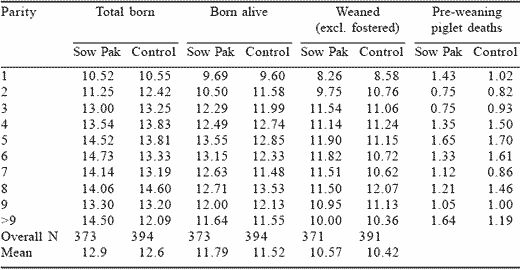
Table 9.The effect of treatment and parity on reproductive performance.

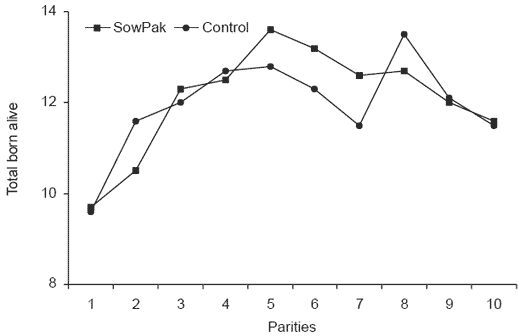
Figure 2.The effect of treatment on the number of piglets born alive.
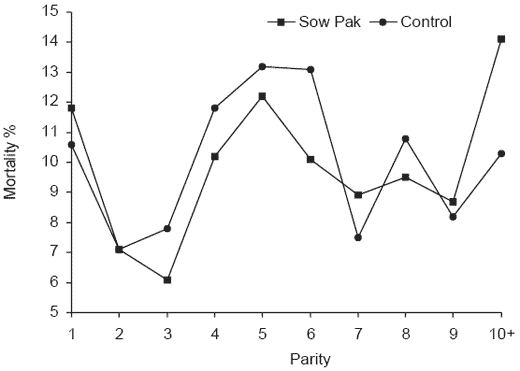
Figure 3.The effect of treatment on pre-weaning mortality (%).
Piglet weight and performance
The litter and mean weight of the piglets at birth and at weaning are presented in Table 10. There was little difference in weights between the two treatments at any of the parities investigated. Litter weaning weights of ~80 kg were achieved in the peak parities at around 26 days of lactation. This is excellent performance and resulted in 28-day corrected piglet weaning weights of ~7.6-7.8 kg. However, there were variations in both litter size and lactation length, which can be accounted for by calculating mean litter growth rate.
This increased with parity and was highest at 2.4 kg/day in the mid parities, with little difference between treatments. Such daily growth rates are well above those commonly achieved in commercial practice.
Table 10.Piglet performance during lactation.
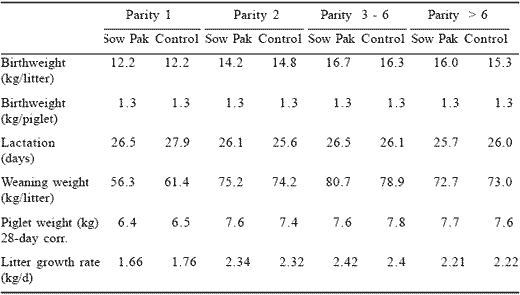
Sow body weight and body weight gain
The trends in the body weight and body weight gain of the sows during the various parities are presented in Tables 11 and 12. At first mating, the gilts weighed 118 kg on both the control and the Sow Pak treatments. The body weights at the end of the trial were also similar at 255 kg for both groups. Thus, the weight gain of the sows throughout the study was similar and unaffected by treatment.
Table 11.Comparison of sow weight (kg) during the various parities.

Table 12.Comparison of the change in sow bodyweight (kg) during the various parities.

In terms of the weight gain of the animals within each parity and overall, there was no obvious effect of treatment. The sows gained weight during pregnancy and lost weight during both lactation and in the wean-to-mating period. The overall net weight gain decreased with parity from approximately 30 kg in parity 1 to 23 kg in parity 2 and 14-18 kg in the following parities.
Backfat thickness of the sows
As indicated in Table 13, there was little difference in the backfat thickness (P2 value) of the sows during the trial. There was a tendency for the sows fed the Sow Pak diet to lose less backfat thickness during lactation than those fed the control diet; and this had an effect on the overall change in P2 at the different parities (Figure 4). There was a general increase in P2 with parity and, with the exception of parities 3–6 where the response was similar, sows fed the Sow Pak diet always gained more than the control animals (Figure 4).
Table 13.The backfat thickness of the sows.

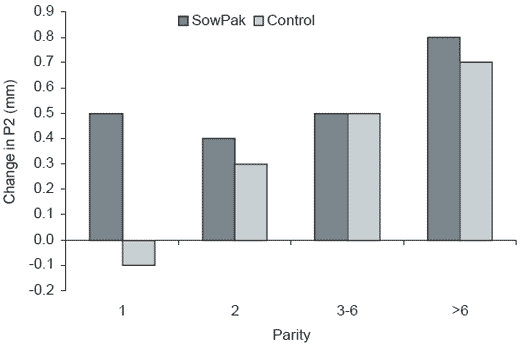
Figure 4.Comparison of the change in backfat (mm) at the different parities.
Body condition scoring
The body condition score of the sows was assessed on a scale of 1–5, as follows:
1 thin 2 below optimum 3 optimum 4 above optimum 5 fat
There was little difference in body condition score of the sows between treatments or at the different parities (Table 14). Generally, the sows gained body condition during gestation, but this was lost during suckling so that the condition score of the sows at mating was constant. The values were close to 3, which is the optimum required for good reproductive performance.
This indicated that the nutritional regime offered to the sows maintained a good body condition. Table 14. Comparison of the body condition score of the sows during the trial.
Table 14. Comparison of the body condition score of the sows during the trial.

Feed consumption
The total and daily quantities of feed consumed by the animals during gestation and lactation at the different parities is presented in Table 15. With the exception of parity 1, feed intake in later parities remained constant during pregnancy. The small variation in consumption during gestation is the result of the feeding strategy during the previous lactation. A sow with minimum loss of condition during lactation is easy to feed in the following pregnancy and this simplifies rationing.
Table 15. Comparison of feed consumption over the different parities.

In lactation, there was a tendency for feed intake to increase with parity until parities 3-6 and then to remain constant. However, within each parity, there was no difference in feed intake between the sows fed the Sow Pak or the control diet. The feed required per kg of piglet weaned was also similar between treatments.
Duration of cycle and annual sow productivity
The weaning-to-mating interval varied between five and eight days, indicating that the sows returned to oestrus promptly after weaning and there was no significant difference between treatments (Table 16). In parity 2, the sows fed the Sow Pak returned to oestrus 1 day earlier than the control sows, but there was no difference in subsequent parities. There was no difference in either the duration of the cycle or the number of parities per sow per year (~2.4 litters per sow per year).
Table 16.Details of sow reproductive cycles.

*including returns to heat
Since both the litter size and the number of potential litters per sow per year are known, it is possible to calculate the annual sow productivity (Table 17). With the exception of parities 1 and 2 when the Sow Pak treatment was introduced, the sows on both treatments produced more than 30 live-born piglets per year. In parities 3-6, the difference between the sows fed the Sow Pak and those fed the control diets was 0.8 extra piglets born alive and 1.0 extra piglets weaned. In later parities, the difference was an extra 1.1 piglet born alive and 0.5 extra piglets weaned per year. There was little difference between treatments in overall pre-weaning piglet mortality.
Table 17.Calculated annual sow productivity.

Sow longevity and lifetime performance
Sows were of differing parities when they were introduced onto the trial at weaning of their respective litters. The trial was carried out over a 24- month period and the data base represented some 742 observations; 356 observations were made on sows on the Sow Pak treatment and 386 observations on control sows and included sows between their 2nd and 12th parity.
Analysis of the data suggested that when the proportion of sows at the different parities was compared, there was little difference between the control and Sow Pak groups over the first four parities (Figure 5). The proportion of sows decreased from 100% in parity 1 to 52-57% in parity 4.
Thereafter there was a difference between the two treatments. The proportion of sows fed the Sow Pak diet was maintained at 50-57% between parities 4 to 8, whereas for the control sows it decreased from 52% in parity 4 to about 20% in parities 6 to 8. Thus, a larger proportion of sows fed the Sow Pak diet were retained and were better able to maintain good productivity in these most productive parities compared with the control sows. It may well be that the provision of the additional organic mineral better met the needs of the animal, enhancing its metabolic, physiological and endocrine status and thus optimising sow productivity.
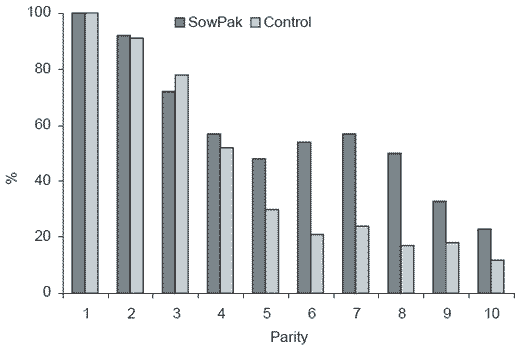
Figure 5.Proportion of litters during the trial.
DISCUSSION
Adding Sow Pak to the diet of sows during gestation and lactation resulted in improved sow productivity compared with that of the controls, although none of the results were significant at P <0.05. However, the performance of the control sows was exceptionally high (29-31 piglets born alive per sow per year from parity 2 onwards) and this was further improved with the addition of Sow Pak. Across all parities, there were 0.2–0.3 extra piglets born alive and weaned in sows fed the diet containing Sow Pak compared with the controls.
However, when the peak parities (parities 3-6) were considered, 0.4 more piglets were born or born alive and 0.5 more piglets were weaned from the sows fed Sow Pak than from the controls. Preweaning mortality, especially in parities 3-6, was also reduced. When the annual sow productivity was calculated (excluding parities 1 and 2 when all sows may not have received Sow Pak) there were 0.8 extra piglets born alive and 1.0 extra piglet weaned in parities 3–6 and 1.1 extra piglets born alive and 0.5 extra piglets weaned per year in the later parities. There was no difference between the two treatments in either the growth rate of the piglets during lactation or their weaning weights; or in the change in body weight or body condition of the sows throughout the trial, or the feed consumption of the animals.
An interesting feature of the results was the greater number of litters produced by the sows fed the Sow Pak and the reduced removal rate, especially between parities 5 and 9. Overall, the sows fed the Sow Pak produced on average 0.9 more litter per sow lifetime, indicating that these sows were better able to maintain productivity, especially in the most productive parities.
It is interesting to speculate on why the improvements in sow productivity occurred on addition of the Bioplex minerals:
1. The control diet contained the recommended mineral allowances, although in the inorganic form. There is concern about the availability of some of these compounds and it may be that they do not meet the animals’ increased requirement for normal reproduction. However, compared with general commercial production, the performance of all the animals in this trial, including those on the control diet, was exceptionally high, suggesting that their mineral requirements were met.
2. It has been suggested that the inclusion of organic minerals better meets the needs of the animal and allows it to express its true genetic potential. Ammerman et al. (1998) have suggested that organic minerals provide the animal with a ‘metabolic benefit’ beyond the usual concept of bioavailability that often results in improved performance.
3. Minerals, such as iron, copper, zinc, manganese, chromium and selenium play specific roles in reproduction (Figures 1 and 2); and if for any reason there is a deficiency in the diet or in the body, then high levels of performance cannot be achieved. In the current trial it is not known whether the effect was due to one element in particular or to the combination of elements.
4. The modern sow is expected to be hyperprolific and her nutritional requirements are therefore high, especially in lactation. On the other hand, the selection for lean tissue growth and feed efficiency has resulted in animals with reduced appetite. Even when fed to appetite in lactation, many sows must mobilise considerable body reserves to meet their metabolic needs. Indeed, Mahan and Newton (1995) have shown that considerable quantities of minerals were mobilised from skeletal structures in sows by the end of their third lactation compared with non-breeding animals; and that the higher the level of performance, the greater the loss of minerals from the body. It may well be that the sow has sufficient mineral reserves in her body to sustain high productivity for 2-3 parities; but while there will be some replenishment of reserves during pregnancy, there may be a gradual depletion over time. This may become apparent in reduced productivity and higher culling rates in later parities. Organic minerals with their high bioavailability may help to redress any imbalance or deficit in the animal and therefore maintain high levels of performance. This could explain the much higher reproductive performance of the sows fed Sow Pak from parity 3 onwards, as well as the much greater proportion of productive animals in the herd and lower removal rates. This suggests that the inclusion of the Sow Pak provides the sow with a greater ‘biosecurity’ throughout her reproductive life, as well as benefiting the piglets.
There are therefore a number of possible mechanisms by which the addition of Bioplex minerals to standard sow diets in the current trial enhanced sow performance and longevity in an already highly productive herd. Indeed, it may well be that the response to the addition of Bioplex minerals during gestation, lactation and post-weaning is even greater in sow herds where performance is limited and below accepted levels of productivity.
Overall conclusions
The provision of a special package of organic minerals, including iron, copper, zinc and manganese, as well as chromium yeast and Sel-Plex, to a standard sow diet further improved the performance of a hyper-prolific herd. The lifetime performance of the animals was also increased, since sow disposal rate was reduced.
The Sow Pak was also provided in the diet of sows on a commercial farm, which was not part of this trial, but which had problems of MMA in sows and piglets scouring in early lactation. There was an improvement in the health status of both the sows and the piglets and an observed reduction in stress in the sows. The beneficial effects of such a package of elements on the quality of the colostrum and the health status of the sows should therefore be further evaluated under a range of commercial farm conditions.
References
RESULTS
General comments In all, the trial involved 742 litters of piglets from sows ranging between parities 2 and 12; 386 on the control and 356 on the Sow Pak diets. However, despite this large data set, there was considerable variation in many of the parameters measured and although there were numerical differences between treatments, few of these were statistically different at P<0.05. This is not surprising, since it is well known that it takes very large sow and piglet numbers to establish significant differences in reproductive traits. Indeed, there was very little difference in many of the parameters measured at the different parities between the treatments. Results have therefore been presented in relation to the early (parities 1 and 2), the most prolific mid parities (parities 3-6) and the later parities (parities >6). Statistical differences were determined using Students t test.
Sow performance and litter size
Table 8 shows the total number of piglets born, born alive and numbers weaned (exclusive of fostered piglets) for the different parities and different treatments throughout the duration of the trial. This information is also presented graphically in Figure 2 for the total number of piglets born alive.
In the first parity there was no difference in performance between the two groups of sows. This is not unexpected, since the Sow Pak was not introduced until the first lactation. In the second parity, the control sows had higher litter sizes than those fed the Sow Pak. This effect is difficult to explain and there appears to be no logical explanation other than the natural variation associated with reproductive traits in sows. However, from parity 3 onwards, the sows fed the Sow Pak generally had higher litter sizes than the control sows.
As expected, litter size increased up to parities 3-6 and then generally decreased. However, the performance of the sows fed the Sow Pak diet was generally better than performance of those fed the control diet. Across all parities, the sows given Sow Pak produced 0.2-0.3 more piglets for the total number of piglets born, born alive and weaned, compared with the controls. However, when the peak parities (parities 3-6) were considered, the sows given the Sow Pak had 0.4 more piglets born or born alive and weaned 0.5 more piglets compared with the controls (Table 9).
The number of fully developed piglets that were born dead and the preweaning mortality is also shown in Table 8 and Figure 3, respectively. Although there was no statistically significant difference (P>0.05) in mortality between the control and Sow Pak treatments, the latter generally had fewer fully developed piglets born dead than the control sows. A greater proportion of piglets of low birthweight (<1 kg body weight) from the Sow Pak fed Organic trace elements and performance of hyper-prolific sows 316 sows died relative to the controls. However, when overall mortality at farrowing was considered, including mummified piglets, there was no difference between the treatments. Generally, the mortality of the piglets pre-weaning was lower in the Sow Pak fed sows than the controls, and especially so in the most productive parities (parities 3-6) (Figure 3). In many parities, pre-weaning mortality was below the generally accepted level of 10%, indicating the high level of management and stockmanship on the farm.
Table 8.The effect of treatment on reproductive performance.

Table 9.The effect of treatment and parity on reproductive performance.


Figure 2.The effect of treatment on the number of piglets born alive.

Figure 3.The effect of treatment on pre-weaning mortality (%).
Piglet weight and performance
The litter and mean weight of the piglets at birth and at weaning are presented in Table 10. There was little difference in weights between the two treatments at any of the parities investigated. Litter weaning weights of ~80 kg were achieved in the peak parities at around 26 days of lactation. This is excellent performance and resulted in 28-day corrected piglet weaning weights of ~7.6-7.8 kg. However, there were variations in both litter size and lactation length, which can be accounted for by calculating mean litter growth rate.
This increased with parity and was highest at 2.4 kg/day in the mid parities, with little difference between treatments. Such daily growth rates are well above those commonly achieved in commercial practice.
Table 10.Piglet performance during lactation.

Sow body weight and body weight gain
The trends in the body weight and body weight gain of the sows during the various parities are presented in Tables 11 and 12. At first mating, the gilts weighed 118 kg on both the control and the Sow Pak treatments. The body weights at the end of the trial were also similar at 255 kg for both groups. Thus, the weight gain of the sows throughout the study was similar and unaffected by treatment.
Table 11.Comparison of sow weight (kg) during the various parities.

Table 12.Comparison of the change in sow bodyweight (kg) during the various parities.

In terms of the weight gain of the animals within each parity and overall, there was no obvious effect of treatment. The sows gained weight during pregnancy and lost weight during both lactation and in the wean-to-mating period. The overall net weight gain decreased with parity from approximately 30 kg in parity 1 to 23 kg in parity 2 and 14-18 kg in the following parities.
Backfat thickness of the sows
As indicated in Table 13, there was little difference in the backfat thickness (P2 value) of the sows during the trial. There was a tendency for the sows fed the Sow Pak diet to lose less backfat thickness during lactation than those fed the control diet; and this had an effect on the overall change in P2 at the different parities (Figure 4). There was a general increase in P2 with parity and, with the exception of parities 3–6 where the response was similar, sows fed the Sow Pak diet always gained more than the control animals (Figure 4).
Table 13.The backfat thickness of the sows.


Figure 4.Comparison of the change in backfat (mm) at the different parities.
Body condition scoring
The body condition score of the sows was assessed on a scale of 1–5, as follows:
1 thin 2 below optimum 3 optimum 4 above optimum 5 fat
There was little difference in body condition score of the sows between treatments or at the different parities (Table 14). Generally, the sows gained body condition during gestation, but this was lost during suckling so that the condition score of the sows at mating was constant. The values were close to 3, which is the optimum required for good reproductive performance.
This indicated that the nutritional regime offered to the sows maintained a good body condition. Table 14. Comparison of the body condition score of the sows during the trial.
Table 14. Comparison of the body condition score of the sows during the trial.

Feed consumption
The total and daily quantities of feed consumed by the animals during gestation and lactation at the different parities is presented in Table 15. With the exception of parity 1, feed intake in later parities remained constant during pregnancy. The small variation in consumption during gestation is the result of the feeding strategy during the previous lactation. A sow with minimum loss of condition during lactation is easy to feed in the following pregnancy and this simplifies rationing.
Table 15. Comparison of feed consumption over the different parities.

In lactation, there was a tendency for feed intake to increase with parity until parities 3-6 and then to remain constant. However, within each parity, there was no difference in feed intake between the sows fed the Sow Pak or the control diet. The feed required per kg of piglet weaned was also similar between treatments.
Duration of cycle and annual sow productivity
The weaning-to-mating interval varied between five and eight days, indicating that the sows returned to oestrus promptly after weaning and there was no significant difference between treatments (Table 16). In parity 2, the sows fed the Sow Pak returned to oestrus 1 day earlier than the control sows, but there was no difference in subsequent parities. There was no difference in either the duration of the cycle or the number of parities per sow per year (~2.4 litters per sow per year).
Table 16.Details of sow reproductive cycles.

*including returns to heat
Since both the litter size and the number of potential litters per sow per year are known, it is possible to calculate the annual sow productivity (Table 17). With the exception of parities 1 and 2 when the Sow Pak treatment was introduced, the sows on both treatments produced more than 30 live-born piglets per year. In parities 3-6, the difference between the sows fed the Sow Pak and those fed the control diets was 0.8 extra piglets born alive and 1.0 extra piglets weaned. In later parities, the difference was an extra 1.1 piglet born alive and 0.5 extra piglets weaned per year. There was little difference between treatments in overall pre-weaning piglet mortality.
Table 17.Calculated annual sow productivity.

Sow longevity and lifetime performance
Sows were of differing parities when they were introduced onto the trial at weaning of their respective litters. The trial was carried out over a 24- month period and the data base represented some 742 observations; 356 observations were made on sows on the Sow Pak treatment and 386 observations on control sows and included sows between their 2nd and 12th parity.
Analysis of the data suggested that when the proportion of sows at the different parities was compared, there was little difference between the control and Sow Pak groups over the first four parities (Figure 5). The proportion of sows decreased from 100% in parity 1 to 52-57% in parity 4.
Thereafter there was a difference between the two treatments. The proportion of sows fed the Sow Pak diet was maintained at 50-57% between parities 4 to 8, whereas for the control sows it decreased from 52% in parity 4 to about 20% in parities 6 to 8. Thus, a larger proportion of sows fed the Sow Pak diet were retained and were better able to maintain good productivity in these most productive parities compared with the control sows. It may well be that the provision of the additional organic mineral better met the needs of the animal, enhancing its metabolic, physiological and endocrine status and thus optimising sow productivity.

Figure 5.Proportion of litters during the trial.
DISCUSSION
Adding Sow Pak to the diet of sows during gestation and lactation resulted in improved sow productivity compared with that of the controls, although none of the results were significant at P <0.05. However, the performance of the control sows was exceptionally high (29-31 piglets born alive per sow per year from parity 2 onwards) and this was further improved with the addition of Sow Pak. Across all parities, there were 0.2–0.3 extra piglets born alive and weaned in sows fed the diet containing Sow Pak compared with the controls.
However, when the peak parities (parities 3-6) were considered, 0.4 more piglets were born or born alive and 0.5 more piglets were weaned from the sows fed Sow Pak than from the controls. Preweaning mortality, especially in parities 3-6, was also reduced. When the annual sow productivity was calculated (excluding parities 1 and 2 when all sows may not have received Sow Pak) there were 0.8 extra piglets born alive and 1.0 extra piglet weaned in parities 3–6 and 1.1 extra piglets born alive and 0.5 extra piglets weaned per year in the later parities. There was no difference between the two treatments in either the growth rate of the piglets during lactation or their weaning weights; or in the change in body weight or body condition of the sows throughout the trial, or the feed consumption of the animals.
An interesting feature of the results was the greater number of litters produced by the sows fed the Sow Pak and the reduced removal rate, especially between parities 5 and 9. Overall, the sows fed the Sow Pak produced on average 0.9 more litter per sow lifetime, indicating that these sows were better able to maintain productivity, especially in the most productive parities.
It is interesting to speculate on why the improvements in sow productivity occurred on addition of the Bioplex minerals:
1. The control diet contained the recommended mineral allowances, although in the inorganic form. There is concern about the availability of some of these compounds and it may be that they do not meet the animals’ increased requirement for normal reproduction. However, compared with general commercial production, the performance of all the animals in this trial, including those on the control diet, was exceptionally high, suggesting that their mineral requirements were met.
2. It has been suggested that the inclusion of organic minerals better meets the needs of the animal and allows it to express its true genetic potential. Ammerman et al. (1998) have suggested that organic minerals provide the animal with a ‘metabolic benefit’ beyond the usual concept of bioavailability that often results in improved performance.
3. Minerals, such as iron, copper, zinc, manganese, chromium and selenium play specific roles in reproduction (Figures 1 and 2); and if for any reason there is a deficiency in the diet or in the body, then high levels of performance cannot be achieved. In the current trial it is not known whether the effect was due to one element in particular or to the combination of elements.
4. The modern sow is expected to be hyperprolific and her nutritional requirements are therefore high, especially in lactation. On the other hand, the selection for lean tissue growth and feed efficiency has resulted in animals with reduced appetite. Even when fed to appetite in lactation, many sows must mobilise considerable body reserves to meet their metabolic needs. Indeed, Mahan and Newton (1995) have shown that considerable quantities of minerals were mobilised from skeletal structures in sows by the end of their third lactation compared with non-breeding animals; and that the higher the level of performance, the greater the loss of minerals from the body. It may well be that the sow has sufficient mineral reserves in her body to sustain high productivity for 2-3 parities; but while there will be some replenishment of reserves during pregnancy, there may be a gradual depletion over time. This may become apparent in reduced productivity and higher culling rates in later parities. Organic minerals with their high bioavailability may help to redress any imbalance or deficit in the animal and therefore maintain high levels of performance. This could explain the much higher reproductive performance of the sows fed Sow Pak from parity 3 onwards, as well as the much greater proportion of productive animals in the herd and lower removal rates. This suggests that the inclusion of the Sow Pak provides the sow with a greater ‘biosecurity’ throughout her reproductive life, as well as benefiting the piglets.
There are therefore a number of possible mechanisms by which the addition of Bioplex minerals to standard sow diets in the current trial enhanced sow performance and longevity in an already highly productive herd. Indeed, it may well be that the response to the addition of Bioplex minerals during gestation, lactation and post-weaning is even greater in sow herds where performance is limited and below accepted levels of productivity.
Overall conclusions
The provision of a special package of organic minerals, including iron, copper, zinc and manganese, as well as chromium yeast and Sel-Plex, to a standard sow diet further improved the performance of a hyper-prolific herd. The lifetime performance of the animals was also increased, since sow disposal rate was reduced.
The Sow Pak was also provided in the diet of sows on a commercial farm, which was not part of this trial, but which had problems of MMA in sows and piglets scouring in early lactation. There was an improvement in the health status of both the sows and the piglets and an observed reduction in stress in the sows. The beneficial effects of such a package of elements on the quality of the colostrum and the health status of the sows should therefore be further evaluated under a range of commercial farm conditions.
References
- Agricultural Research Council. 1981. The nutritional requirements of pigs. CAB Slough, UK.
- Ammerman, C.B., P.R. Henry and R.D. Miles. 1998. Supplemental organically-bound mineral compounds in livestock nutrition. In:Recent Advances in Animal Nutrition - 1998. (P.C. Garnsworthy and J. Wiseman eds.). Nottingham University Press, Loughborough, Leics. UK. pp 67- 91.
- Close, W.H. 1999. Organic minerals for pigs: an update. In: Biotechnology in the Feed Industry, Proceedings of the 15th Annual Symposium (T.P Lyons and K.A. Jacques, eds). Nottingham University Press, Nottingham, Leics. UK. pp. 51-60.
- Fehse, R. 1999. 30 Ferkel pro Sau und Jahr? Interne Publikation, Haefliger AG. Herzogenbuchsee, Switzerland.
- Mahan, D. and Newton, C.A. 1995. Effect of initial breeding weight on macro- and micromineral composition over a three-parity period using a high-producing sow genotype. J. Anim. Sci. 73:151-158.
- National Research Council. 1998. Nutritional requirements of swine. National Academy Press, Washington, USA.
Authors: ROBERT FEHSE1 and WILLIAM H. CLOSE2
1 Fehse Consultancy, Berg, Switzerland
2 Close Consultancy, Wokingham, United Kingdom
1 Fehse Consultancy, Berg, Switzerland
2 Close Consultancy, Wokingham, United Kingdom
Related topics:
Authors:
Close Consultancy
Recommend
Comment
Share

Would you like to discuss another topic? Create a new post to engage with experts in the community.






.jpg&w=3840&q=75)